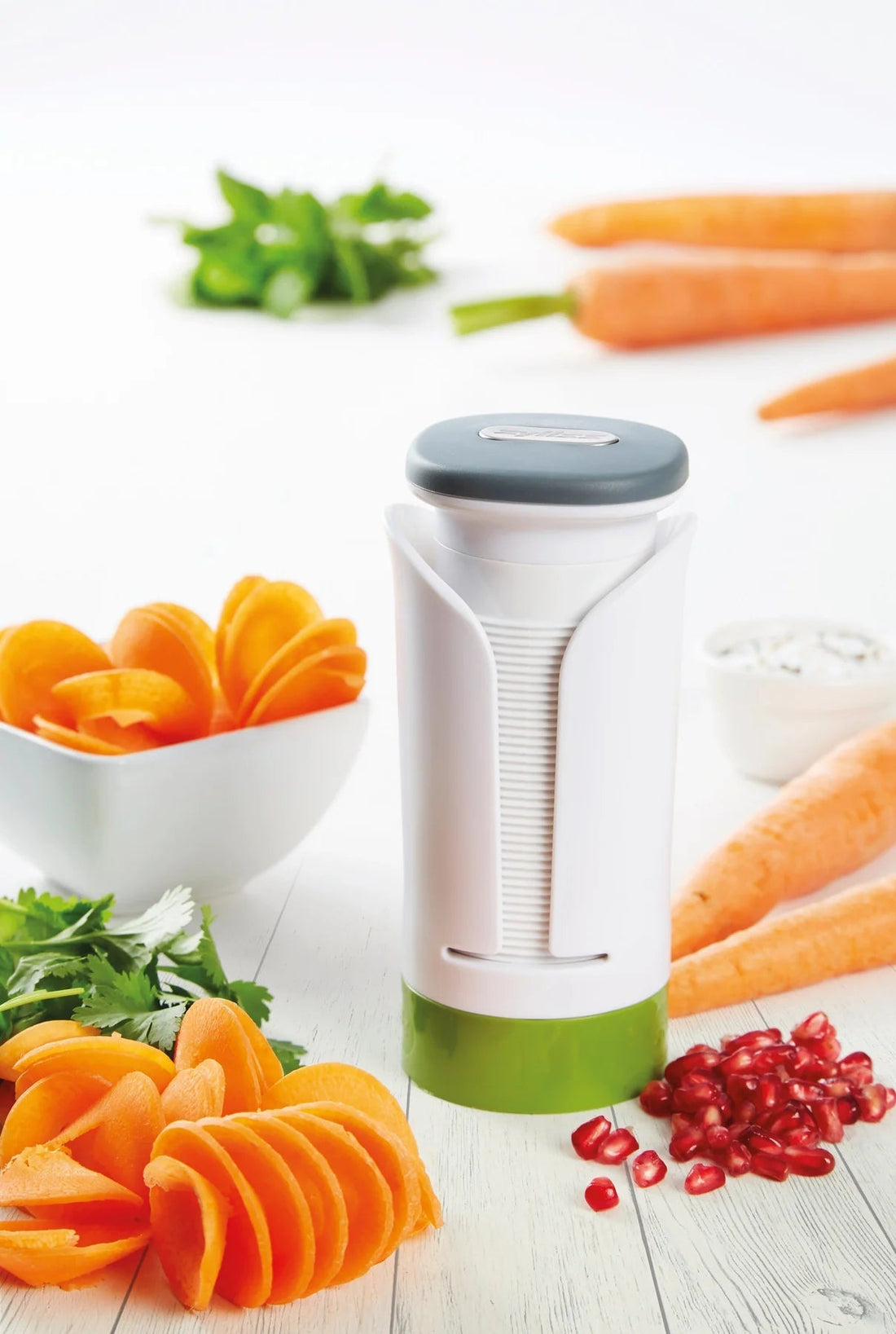
What is a spiralizer?
Give your meals a healthy boost with a handy kitchen gadget that uses a rotating blade to create long vegetable strips. At first glance, spiralized dishes can appear intricate and daunting. Surely all those even slices must take hours to produce? While you can use a paring knife or peeler to cut veggies into julienne sticks, this can be time consuming and dangerous as the knife may slip. With a Zyliss Spiralizer, your fingertips are kept safely away from the blades, and you can achieve brilliant results in a fraction of the time. Add a fresh twist to your weekday dinners - literally - and enjoy meals packed with vitamins and vibrancy.
What can you use a spiralizer for?
Ever find yourself in a food rut, preparing the same meals night after night? A spiralizer provides the perfect opportunity to get creative in the kitchen and try out some innovative new recipes. Spiralizers are ideal for carb-conscious chefs who fancy reducing their pasta intake. You can use them to produce courgette spaghetti or butternut squash tagliatelle. Pair with a hearty tomato bolognese or a creamy garlic sauce for a tasty dinner without the carb-hangover. Not only will your meal be lighter and full of flavor, but you'll be getting a hidden micronutrient top-up, too.
Some spiralizers, like the Zyliss SmoothSlizer Veggie Pasta Maker, feature interchangeable blades to produce ribbons, spirals, and sheets. When fast food cravings come a-calling, why not try making your own curly fries? Using the spiral blade, you can create sweet potato curls. For a crispy, guilt-free snack, drizzle them with olive oil and a sprinkle of sea salt, then pop them in the oven to bake.
What are the best foods to spiralize?
You can use a spiralizer to make the most of a whole variety of veggies. Why limit your options to only savory dishes? Once you get going, you can let your imagination roam free. Spiralizers come in different shapes and styles. Some are cylindrical, with a blade at the bottom. You pop the ingredients inside the tube then press and twist with the pusher. These spiralizers are best suited to long, narrow vegetables such as courgettes and cucumbers. Freestanding spiralizers give you a bit more versatility as you don't have to squeeze the veggies into a tube. Instead, you place the ingredient on the skewers and turn the handle. The vegetable presses against the sharp blade as it rotates. This format gives you more space for bulkier produce, like squash and sweet potato.
Firm fruits, like apples and pears, can be spiralized just as effectively as salad ingredients. Reinvent a classic pudding by spiralizing your fruit instead of chopping it into standard pieces. Quick and effective - you can even leave the skin on. Dust the filling with cinnamon and top with a thick layer of crumble mix or a puff pastry lid. As the fruit cooks, filling your kitchen with cozy aromas, your dessert will have a fantastic new texture dynamic.
How to get the best results with your spiralizer
Depending on the spiralizer type - twist and push or freestanding - you may need to trim your ingredients for optimum results. Many kitchen appliances have interchangeable blades. You can experiment to see which one works best for your desired dish. Some vegetables retain more nutrients raw. Others release more of the good stuff when they're cooked. This knowledge can help you make the most of your ingredients and their health benefits. The beauty of courgette, butternut squash, and sweet potato is that they are delicious and healthy however they're prepared. If you're making pasta-replacement dishes, you can boil or steam your courgette or squash alternatives. When preparing aubergine lasagne, you may need to cook it more gently, as it tends to fall apart when cooked.
Can you store spiralized foods for later?
You can keep spiralized vegetables in the fridge for up to three days, and storing them in a bowl of water will keep them crisp. This is handy if you're meal prepping for the week ahead. Ingredients like apples, parsnips, and celeriac tend to oxidize and turn brown after a while, but a squeeze of lemon juice can preserve them for longer. Most spiralized veggies can also be frozen. Freezing butternut squash, carrot, and sweet potato is a great way to reduce waste. You can thaw them overnight or add them straight to your pan from frozen. However, ingredients with a high water content, such as cucumber and courgette, tend to disintegrate when they thaw out.
What should I look for in a spiralizer?
When choosing a spiralizer, it's good to think about the kitchen space you have available. Some freestanding spiralizers can be bulky. Twist and push ones, on the other hand, are more compact. With freestanding models, you also want to look for a sturdy non-slip base. If you're preparing spiralized veggies in bulk, you might like to try an electric option. They tend to be more expensive than manual options but will prevent arm fatigue.
Going for a spiralizer with multiple, interchangeable blades, like the Zyliss SmoothSlizer Veggie Pasta Maker is a great choice if you want to try out different styles of vegetable cuts. The SmoothSlizer is also dishwasher-safe, making it easy to clean and look after.

